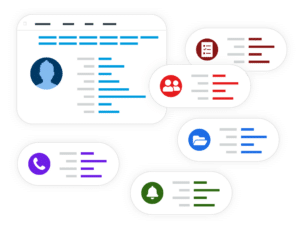What Is the Real ROI of a Customer?
The value of a customer is an age-old debate among company executives and changemakers, and often it narrows down to how much revenue a customer gives to the business. Even if it seems like a reasonable metric on the surface, it’s a pretty cut-and-dried way of looking at it.
Your customers expect the best across every touchpoint of the buying cycle, from personalization to support channels. And if your business doesn’t provide it, they’ll find a competitor that will.
Think about yourself as a customer. Imagine a time you had a great experience with a business and how you felt about it. Now, consider how you reacted to the bad experiences with other businesses. How could the negative experiences be better? What made you continue doing business with the company that provided the better experience?
Answering those questions and applying them to your own business is the core of understanding the true value of every one of your customers.
Understanding the Value of Customer Experiences
There’s increasing discussion around customer experience, or CX, and how it drives business growth. You only have to think about the answers to the above questions to understand how great experiences affect your customers. We all have brands we love, businesses we follow religiously, and websites we visit without fail.
If you’re a changemaker in service and support or in customer success, you already know this intuitively. You understand that the customer experience is just as important as cost and quality. But you know you need data to back this up—after all, we’re paid to think and then act, not simply go with our gut.

And while we recognize great CX when we experience it ourselves, it’s still treated as a soft discipline. Even though business leaders understand its value, it’s often difficult to quantify. It’s challenging to assess the value of opinions and emotions—they’re just too subjective.
But the correlation is there. Customers who have great experiences spend up to 140% more than those who don’t. But even correlation is a tough sell to executives who deal in cold, hard facts. What’s needed is a way to quantify the value of CX.
Quantifying CX with Modern Tools
Today’s buyer journeys are very different from ten years ago. You now have modern tools to track and identify your customer’s pain points, understand their preferences, and maximize the experience for your target customer. Also, they provide you with the means to track how those efforts directly impact your bottom line. They help you transform your customer service discipline into a science—one you can measure and quantify.
Consider customer loyalty for a moment. While you can measure customer ROI based on how much money they give your business for the year, you still have to invest in keeping them happy and loyal. But how does a company measure such a thing?

First, you have to understand what drives customer loyalty. You might think that delivering value through great products and services at competitive costs is the central premise. While this is undoubtedly important, it’s not what determines whether your customers continue doing business with you.
In a 2019 study, Gartner found that customer effort is the most significant measure in determining loyalty. Over 90% of customers with a high-effort interaction became disloyal compared to less than 10% for easier interactions. High-effort experiences include things such as:
- Generic and impersonal service
- Repeated information and interactions
- Channel switching
Think about that for a second. If customers interacting with your business requires too much effort on their part, they might start looking at your competitors. This alone demonstrates the importance of providing a great customer experience.
These low and high-effort interactions affect more than customer loyalty. The same study found that providing good customer experiences impacts everything from repurchase rates to employee retention. Even costs are significantly affected, with low-effort interactions costing businesses 37% less than high-effort ones.
It All Starts With Data and Analytics
Data is the driving force behind the emergence of CX as a science. The data is the key, from the countless interactions your customers have at every touchpoint of your business to their buying journey and the experience they have with your customer service teams. Implementing ways to collect and measure this data is the first step to improving your business’s CX.

You need tools that provide automated data acquisition without entering these data manually, adding more extra work. The best tools offer real-time alerts that monitor account activity and let your support team know when accounts are the most engaged or at risk of churning.
Another consideration is your customer’s sales journey. Modern tools that collect data and provide detailed intelligence about these journeys are indispensable in your CX efforts. With the right intelligence, you can identify pain points and build workflows around maximizing engagement and minimizing lost prospects.
And, of course, focusing on your support efforts is central to providing fantastic CX. To stay ahead of the curve, you need tools to collect a robust dataset for every one of your customers and provide you with a complete view of what they want, need, and expect from your business. The best tools can even streamline your support efforts through omnichannel communications, putting all of your customer’s interactions at your team’s fingertips.
The high quality customer support these tools offer rounds out the customer experience and ensures positive word of mouth that feeds back positively into the marketing process. With the right tools that collect and build on the vast amounts of data available, businesses can begin providing the unique experiences their customers expect. And they can do it in ways that are measurable and quantifiable.
The Benefits of CX
As you can see, the science of CX is crucial to the success of your business. Using the right tools to examine and refine the experiences your customers have carefully is paramount to keeping them happy and loyal. But improved customer loyalty is only the beginning. CX has a much wider and deeper impact than simply ensuring your customers continue doing business with you.
Improved Marketing Efforts
Customer loyalty is the best marketing money can buy. A loyal customer promotes your products and services to their friends and family and advocates for your brand. And while word-of-mouth marketing isn’t a new concept, it has a much more significant impact in the age of social media.

Imagine the influencers in your industry, the people with a successful blog and an extensive social media following. These people don’t just influence the opinions of their friends and family—they change the minds of millions with their powerful insights and thought leadership. When you create loyal customers from these individuals, you tap into a powerful resource that bolsters your marketing efforts.
Consider these points:
- Brand ambassadors give your business a human touch. They make your business more accessible to your prospects, increasing the chances they’ll engage with you.
- They lend your brand an air of authenticity. Consumers are skeptical of the promises made by a business, especially if it’s one they’re unfamiliar with. But when those messages come from an independent authority they trust and follow, they’re far more effective than anything your marketing efforts could say.
- They change people’s minds. Independent champions for your brand can help mold people’s perceptions of your business. They improve recruiting efforts, public relations and even serve as outside sales reps. By rallying their strong social media presence around your business, they invigorate your social presence and deliver those hard-to-get prospects.
You only need to look at the numbers to understand brand ambassadors’ power. Nearly 90% of all marketers say influencer marketing is on par with or better than other marketing channels. Brand ambassadors are veritable superchargers for word-of-mouth marketing.
Many companies invest in traditional influencer marketing or brand ambassador programs. It’s so effective that 57% of companies use influencers as part of their marketing mix. But you can start bolstering your word-of-mouth marketing right now by focusing on your business’s CX. Organically, you can lay the seeds to grow brand advocates for your business by providing outstanding CX.
Decreased Customer Churn
Focusing on acquiring new customers is an important growth factor. But focusing on this alone without thinking about what you need to do to take care of your existing customers is a costly mistake. Getting new clients costs businesses anywhere from five to 25 times more than taking care of existing ones. The same report shows that increasing customer retention by just 5% increases profits by 95%.
In other words, decreasing customer churn should be a serious part of your business strategy. And you do that by focusing on the experience of your customers. A study by Dimension Data shows 92% of businesses saw an increase in customer loyalty by focusing on CX, and 82% of them saw an increase in revenue. The message is clear: Invest in CX to keep your customers.
Ignoring CX Benefits Your Competitors
Maybe you’re a business owner still skeptical about spending on CX over things like product development or advertising. Or perhaps you’re a changemaker in your organization trying to convince the decision-makers of the efficacy of investing in CX. The following statistics might help persuade the necessary individuals. It’s not just products and prices that count with customers anymore, and business leaders know this. Two-thirds of companies compete on CX, up from 36% only ten years ago. Considering 90% of business leaders cite CX as their biggest growth engine—higher than any other area—it’s easy to see why. And it’s precisely why nearly 90% of all companies now have a CXO or a similar executive to drive their customer experience efforts.
Underestimating how vital the customer experience is to your business is the last thing you want to do. You’re essentially wrapping your revenues in a big bow and handing them over to your competitors.
Your Customers Are Your Bottom Line
As customer service has evolved from a discipline into the science of customer experiences, so did the companies. CX is no longer an afterthought—it’s one of the driving forces in business today. With fierce competition delivering more options, customers have much more power and expect amazing experiences from the products and services they choose. This makes customer experience a serious engine to higher revenues and growth for every business.

But there’s an important distinction to make between a customer-focused company in the traditional sense and one that puts its customers at the core of what it does. The former are businesses that issue cliché marketing messages and continue looking at the bottom lines to guide their strategies. These businesses will continue to fall to the wayside and make room for the latter by ignoring the obvious signs.
These are the businesses that deliver on their messages by leveraging the right data and the best tools to provide exceptional experiences to every one of their customers. These businesses use the right tools and methods to build a company culture of customer obsession. They’re the businesses that listen to their customers, understand their pain points and address them and build lasting relationships with their customers.
By now, the benefits of investing in CX should be clear. Taking care of your customers is no longer the right thing to do—it’s an engine for measurable growth.
Improving Customer ROI with SugarCRM
Building unique experiences for your customers is crucial to your business’s growth. Creating a culture of customer obsession is not just a smart strategy; it’s a necessary one if you want to remain a competitive force in your industry. But you need the right data and the right tools to get there.
SugarCRM provides those tools. With our CRM, you have everything you need to analyze and refine your CX and differentiate your business from the competition. By combining precision data collection with the best analytical tools, we help you lay the foundation to create exceptional customer experiences. From marketing and sales automation to customer service, the platform works for you—not the other way around. Start learning about our platform today by requesting a demo.

